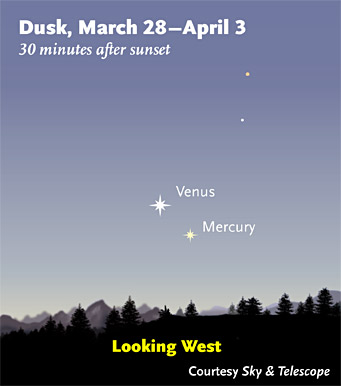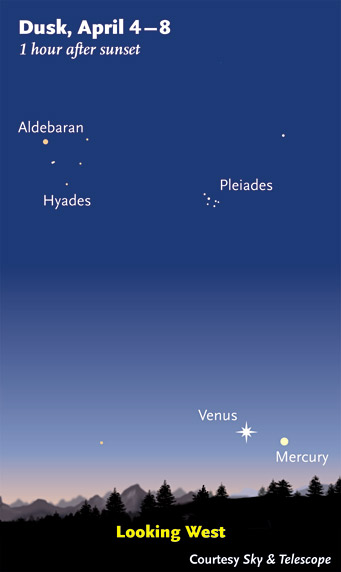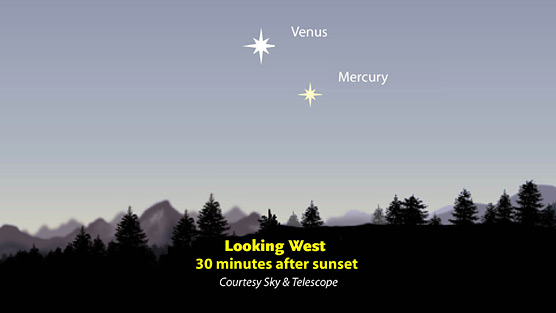Contacts:
Alan MacRobert, Senior Editor
855-638-5388 x2151, [email protected]
Tony Flanders, Associate Editor
855-638-5388 x2173, [email protected]
Note to Editors/Producers: This release is accompanied by three high-quality illustrations; see end of release.
For about the next 10 days, the two closest planets to the Sun will shine together low in the twilight after sundown. Anyone can see them; they’ll form an eye-catching pair. You’ll just need a clear sky and an open view toward the west about 30 to 60 minutes after sunset.
“Mercury is pretty hard to spot most of the time, so a lot of people have never recognized it in their lives,” says Alan MacRobert, a senior editor of Sky & Telescope magazine. “Now’s your chance. This is as good as Mercury gets, especially with Venus marking the way.”

Bright Venus and lesser Mercury form an eye-catching pair low in the western twilight during late March and early April 2010. (Click image for high-res version.)
Sky & Telescope magazine
Venus is the brighter of the two planets. It’s the famed “Evening Star,” currently making its way out from behind the glare of the Sun into twilight view.
Look for Mercury glittering to Venus’s lower right from now through about April 3rd, and almost directly to Venus’s right from about April 4th through 10th. (This is for the latitudes of the United States, Canada, and southern Europe.) Their exact orientation each evening will depend a bit on your latitude.
They'll appear closest together on April 3rd and 4th.
By April 10th Mercury will be fading rapidly, as it swings toward the direction between Earth and the Sun and shows us less and less of its sunlit side.

Look for bright Venus and lesser Mercury shining together low in the west as twilight fades. (Click image for high-res version.)
Sky & Telescope
Although the two planets appear close together, they’re not. Venus is about 1½ times farther away. On April 3rd Mercury and Venus are 94 million and 146 million miles from Earth, respectively. That means it takes their light 8.4 and 13 minutes to reach us.
Three reasons conspire to make Venus shine so brightly despite its greater distance at present. It’s about twice the diameter of Mercury; it’s covered with brilliantly reflective white clouds compared to Mercury’s dark gray rocks and dust; and Venus is currently showing us more of its sunlit dayside.
“Don’t miss this chance to do a little astronomy from your backyard, balcony, or rooftop,” says Sky & Telescope associate editor Tony Flanders. “It’s a big universe, and planets await.”
For more skywatching information and astronomy news, visit SkyandTelescope.com or pick up Sky & Telescope, the essential magazine of astronomy since 1941.
ILLUSTRATIONS: Sky & Telescope is making the three illustrations here available to editors and producers. Click on each to get a high-resolution version. Permission is granted for one-time, nonexclusive use in print and broadcast media, as long as credit is given to Sky & Telescope magazine. Web publication must include a link to SkyandTelescope.com .

Looking west in twilight, March 29 - April 3, 2010.
Click image for a 1920-by-1080-pixel version sized for HDTV.
Sky & Telescope magazine
 0
0
Comments
You must be logged in to post a comment.